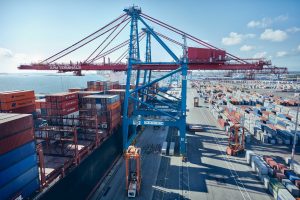 The Port of Gothenburg has announced that in September, the container traffic has remained unchanged while other segments are regaining lost ground following the downturn earlier in the year. In general, the freight volumes at the port have remained stable, despite the ongoing effect the Covid-19 pandemic is having on world trade.
The Port of Gothenburg has announced that in September, the container traffic has remained unchanged while other segments are regaining lost ground following the downturn earlier in the year. In general, the freight volumes at the port have remained stable, despite the ongoing effect the Covid-19 pandemic is having on world trade.
During January – September 2020 the container traffic was the same as in the similar period of 2019, with a volume of 579,000 TEUs. In July – September 2020 the container TEU decreased by 9%, from 194,000 TEUs in 2019, to 177,000 TEUs. The port says that although Swedish industry managed to maintain momentum during the spring, the Covid-19 reaction finally filtered through during the summer months, with a subsequent impact on the number of containers passing through the port.
“The outlook has been brighter since September and that will definitely be the case in the months ahead. Despite obvious concern about a possible second wave of the pandemic and the reverberations, higher volumes are forecast, the market is beginning to shape up, and we expect to close the year in the black,” Elvir Dzanic, Gothenburg Port Authority chief executive, said.
By national and international standards, container handling at the Port of Gothenburg continued to hold its own. Figures published by the industry organisation Ports of Sweden show that the port has increased its share of the Swedish market by 2% this year. The ten largest European ports have taken an 8% fall on average during the first half of the year.
The number of Ro-Ro units handled through to September was down 11% on the same period in 2019. Even though the year started off with a slump, the third-quarter figure, a 6% decrease, is a tentative sign that the negative curve is levelling off. New vehicle handling at the Port of Gothenburg fell by 19%vduring the first nine months. The fall in the wake of Covid-19 was mainly during the second quarter with handling volumes down by almost half. Despite the recovery during the third quarter, year-on-year figures reveal a decline of 8%.
Handling of energy products was up by 3% for January-September period compared with the same period last year. The increase can be attributed to large-scale stockpiling of energy products during the spring. However, stockpiling has slowed during the autumn, and the situation has been compounded further by low margins at the refineries. Handling during the third quarter fel by 26% compared with Q3 2019.
The freight carried in January – September 2020 by rail recorded a 3% decrease compared to the same period of 2019, from 343,000 tonnes to 334,000 tonnes. During July – September 2020, the rail traffic recorded a 11% decrease, compared to July – September 2019, from 194,000 tonnes to 177,000 tonnes.
Share on:



